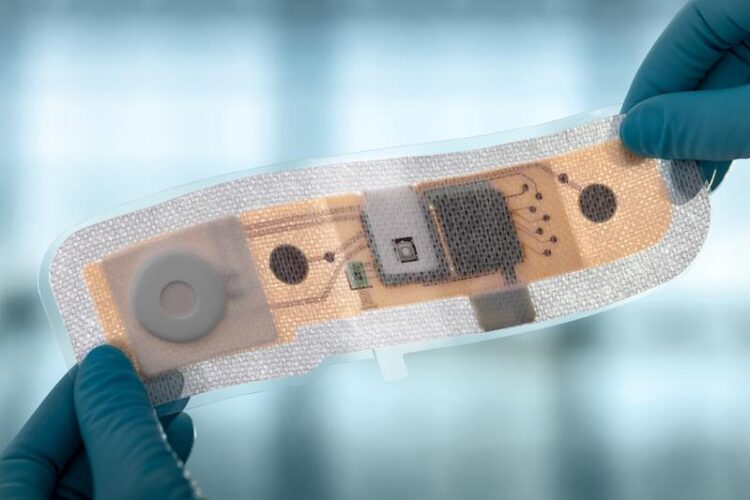ECG with a patch

The patch with sensors, electronics and battery can easily be stuck on the upper body.
© Fraunhofer IZM / Volker Mai
APPLAUSE European collaborative project successfully completed.
Researchers from Fraunhofer IZM, together with 31 partners from industry and research, have developed a stretchable and wireless patch that can be used to make it possible to conduct diagnostically relevant cardiac monitoring in everyday life. This will reduce the number of inpatient examinations required for high-risk patients. It also boosts the semiconductor value chain for the medical sector in Europe through the development of new tools, methods and processes for series production.
Tracking everyday fitness with smartwatches is now part of everyday life for many people. A glance at your smartphone can show you your pulse, step count, sleep quality or even heart rhythm. This kind of information on heart health can now be supplemented by much more complex health data and help with medical diagnoses. The demonstrator created as part of the European Union-funded ESCEL project APPLAUSE (“Advanced packaging for photonics, optics and electronics for low-cost manufacturing in Europe”) is as thin as an ordinary plaster. Inside, it hides sensors and tiny electronics for long-term heart monitoring. Once stuck on, the Plug&Play patch can be used for cardiological monitoring of patients. This means that vital data such as oxygen saturation in the blood, chest movement and bio-impedance can be measured and transmitted directly to an app for monitoring by clinical staff. The researchers at Fraunhofer IZM have been focusing on system and circuit development, assembly and connection technology as well as the integration of a densely packed circuit carrier into the patch.
Improved comfort with TPU
Thermoplastic polyurethane (TPU) was used as the backing film for the patch, which is highly comfortable to wear on the body due to its flexibility and stretchability. The material can also be processed cost-effectively using common PCB technologies, such as the assembly of components with pick-and-place machines. This advantage was utilised through the integration of the electrical functionalities into a dual system-in-package (SiP) design, which was mounted directly on the flexible printed circuit board. Würth Elektronik Circuit Board Technology was involved in the design of the circuit boards and the production of the substrates. To achieve this, new ultra-flexible and rigid-flexible assembly variants were designed alongside project partner OSYPKA AG; the PCBs were manufactured using the skin-friendly substrates.
Integration technologies consistently developed
The project also showed the feasibility of robust encapsulation of thin circuit carriers equipped with components of different heights on TPU. The high level of miniaturisation and tight integration ultimately resulted in a very unobtrusive form factor, with the stretchable PCB providing a highly compliant and biocompatible substrate. Printing the electrodes directly on the flexible printed circuit board and integrating all the electronics into a textile substrate have been key advances in the development of medical patches for monitoring bodily functions. Christine Kallmayer, project manager at Fraunhofer IZM, expressed her satisfaction with the results: “A few years ago, an electronic patch like this for monitoring the heart would have been unimaginable. It has only been the advancement of integration technologies that mean it is now possible to miniaturise medical technology to the point where it can be used as a biocompatible and stretchable patch rather than a rigid device.”
The APPLAUSE demonstrator and other research highlights from Ms Kallmayer’s “System on Flex” group will be presented this year at COMPAMED in Düsseldorf from 13-16 November 2023.
The project is part of the APPLAUSE project, which is funded by the European Union’s Horizon 2020 research and innovation programme as part of the ECSEL Joint Undertaking to the tune of 34.5 million euros. Other project partners included Würth Elektronik Circuit Board Technology, the Interuniversitair Micro-Electronica Centrum (IMEC), Precordior OY, the Fraunhofer Institutes ENAS and IMS as well as 26 other European partners from industry and research, which are listed here: https://www.elektronikforschung.de/projekte/applause
Wissenschaftliche Ansprechpartner:
Christine Kallmayer l Phone +49 30 46403-228 l christine.kallmeyer@izm.fraunhofer.de | Fraunhofer Institute for Reliability and Micro-integration IZM, Berlin www.izm.fraunhofer.de
Originalpublikation:
https://www.izm.fraunhofer.de/en/news_events/tech_news/ecg-with-a-patch.html
Media Contact
All latest news from the category: Medical Engineering
The development of medical equipment, products and technical procedures is characterized by high research and development costs in a variety of fields related to the study of human medicine.
innovations-report provides informative and stimulating reports and articles on topics ranging from imaging processes, cell and tissue techniques, optical techniques, implants, orthopedic aids, clinical and medical office equipment, dialysis systems and x-ray/radiation monitoring devices to endoscopy, ultrasound, surgical techniques, and dental materials.
Newest articles

A universal framework for spatial biology
SpatialData is a freely accessible tool to unify and integrate data from different omics technologies accounting for spatial information, which can provide holistic insights into health and disease. Biological processes…

How complex biological processes arise
A $20 million grant from the U.S. National Science Foundation (NSF) will support the establishment and operation of the National Synthesis Center for Emergence in the Molecular and Cellular Sciences (NCEMS) at…

Airborne single-photon lidar system achieves high-resolution 3D imaging
Compact, low-power system opens doors for photon-efficient drone and satellite-based environmental monitoring and mapping. Researchers have developed a compact and lightweight single-photon airborne lidar system that can acquire high-resolution 3D…





















